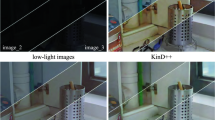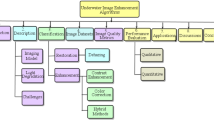Abstract
The issue of underwater image haze removal is investigated in this paper. The exponential attenuation phenomenon in the underwater light propagation process causes the low contrast, color distortion, and blurred edges problems of underwater images and consequently limits the application of the vision-based underwater technology. To overcome these problems, an adaptive color correction method is proposed for underwater single image haze removal. First of all, the estimated transmission map by image blurriness is adopted in the image formation model to remove the haze of underwater images. Secondly, the alternating direction method of multipliers and the histogram displacement in the Lab color space are used to improve the uniform brightness and to correct the color distortion of the restored underwater images. Finally, both qualitative and quantitative experimental results show that the proposed method can produce better restoration results in different underwater scenes compared to other state-of-the-art underwater image restoration methods.








Similar content being viewed by others
References
Wang, Y., Song, W., Fortino, G., et al.: An experimental-based review of image enhancement and image restoration methods for underwater imaging. IEEE Access. 7, 140233–140251 (2019)
Raveendran, S., Patil, M.D., Birajdar, G.K.: Underwater image enhancement: a comprehensive review, recent trends, challenges and applications. Artif. Intell. Rev. 54, 5413–5467 (2021)
Xie, H., Liang, J., Wang, Z., et al.: Scanning imaging restoration of moving or dynamically deforming objects. IEEE Trans. Image Process. 99, 1–1 (2020)
He, K., Sun, J., Fellow, et al.: Single image haze removal using dark channel prior. IEEE Trans. Pattern Anal. Mach. Intell. 33(12), 2341–2353 (2011)
Ren, W., Pan, J., Zhang, H., et al.: Single image dehazing via multi-scale convolutional neural networks with holistic edges. Int. J. Comput. Vis. 128(8), 240–259 (2019)
Han, M., Lyu, Z., Qiu, T., et al.: A review on intelligence dehazing and color restoration for underwater images. IEEE Trans. Syst. Man Cybern. Syst. 50, 1–13 (2018)
Drews-Jr, P.D., Nascimento, E. D, Moraes, F., et al.: Transmission estimation in underwater single images. In: The IEEE International Conference on Computer Vision Workshops. Washington, USA, pp. 825-830 (2013)
Galdran, A., Pardo, D., Picón, A., et al.: Automatic red-channel underwater image restoration. J. Vis. Commun. Image Represent. 26, 132–145 (2015)
He, K., Sun, J., Tang, X.: Guided image filtering. IEEE Trans. Pattern Anal. Mach. Intell. 35(6), 1397–1409 (2013)
Levin, A., Lischinski, D., Weiss, Y.: A closed-form solution to natural image matting. IEEE Trans. Pattern Anal. Mach. Intell. 30(2), 228–242 (2007)
Akkaynak, D., Treibitz, T.: A Revised underwater image formation model. In: Proceedings of the IEEE Conference on Computer Vision and Pattern Recognition (CVPR), pp. 6723–6732 (2018)
Akkaynak, D., Treibitz, T.: Sea-thru: A Method For Removing Water From Underwater Images. In: Proceedings of the IEEE/CVF Conference on Computer Vision and Pattern Recognition (CVPR), pp. 1682–1691 (2019)
Li, C., Guo, C., Ren, W., et al.: An underwater image enhancement benchmark dataset and beyond. IEEE Trans. Image Process. 29, 4376–4389 (2020)
Long, C., Lei, T., Feixiang, Z. et al.: A Benchmark dataset for both underwater image enhancement and underwater object detection. In: 2020 IEEE/CVF Conference on Computer Vision and Pattern Recognition (CVPR). IEEE (2020)
Peng, Y.T., Cosman, P.C.: Underwater image restoration based on image blurriness and light absorption. IEEE Trans. Image Process. 26(4), 1579–1594 (2017)
Jobson, D.J., Rahman, Z.U., Woodell, G.A.: Properties and performance of a center/surround Retinex. IEEE Trans. Image Process. 6(3), 451–462 (1997)
Guo, X., Li, Y., Ling, H.: LIME: low-light image enhancement via illumination map estimation. IEEE Trans. Image Process. 26(2), 982–993 (2017)
Lee, S.: An efficient content-based image enhancement in the compressed domain using Retinex theory. IEEE Trans. Circuits Syst. Video Technol. 17(2), 199–213 (2007)
Song, W., Wang, Y., Huang, D., Tjondronegoro, D.: A rapid scene depth estimation model based on underwater light attenuation prior for underwater image restoration. In: Advances in Multimedia Information Processing pp. 678–688 (2018)
Xue, X., Hao, Z., Ma, L., et al.: Joint luminance and chrominance learning for underwater image enhancement. IEEE Signal Process. Lett.rs 28, 818–822 (2021)
Jiang, K., Wang, Z., Yi, P., et al.: Rain-free and residue hand-in-hand: a progressive coupled network for real-time image Deraining. IEEE Trans. Image Process. 30, 7404–7418 (2021)
Jiang, K., Wang, Z., Yi, P., et al.: Decomposition makes better rain removal: an improved attention-guided Deraining network. IEEE Trans. Circuits Systems Video Technol. 14(8), 1–14 (2020)
Author information
Authors and Affiliations
Corresponding author
Additional information
Publisher's Note
Springer Nature remains neutral with regard to jurisdictional claims in published maps and institutional affiliations.
This work was supported in part by the National Key Research and Development Program of China (Project No.2016YFC0301700), in part by the National Natural Science Foundation of China (Project No.61903304), in part by the Fundamental Research Funds for the Central Universities (Project No.3102020HHZY030010), and in part by the 111 Project under Grant No.B18041.
Rights and permissions
About this article
Cite this article
Zhang, W., Liu, W., Li, L. et al. An adaptive color correction method for underwater single image haze removal. SIViP 16, 1003–1010 (2022). https://doi.org/10.1007/s11760-021-02046-6
Received:
Revised:
Accepted:
Published:
Issue Date:
DOI: https://doi.org/10.1007/s11760-021-02046-6




